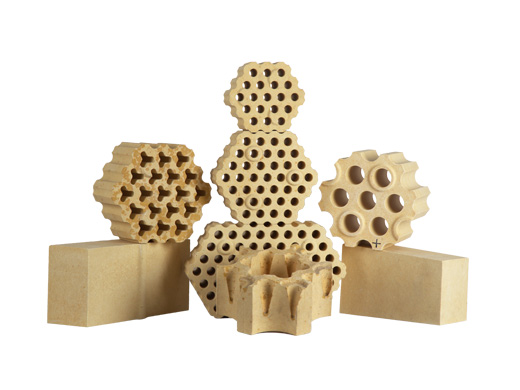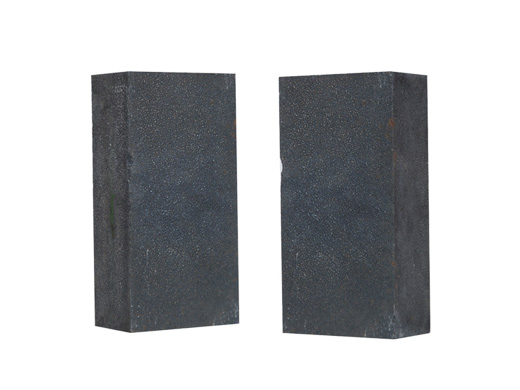Introduction of magnesia ferrousspinel bricks
Industry news | Refractory Wiki | Refractory news | Enterprise news |Introduction of magnesia ferrousspinel bricks
Magnesia ferrousspinel bricks are a new generation of chrome-free basic refractories for the firing zone of large-scale rotary kilns. They use high-purity spinel as raw materials, and are sintered at high temperature to form chrome-free refractories. Environmentally friendly products. The product has the characteristics of high compressive strength, good thermal shock stability, good thermal creep resistance, corrosion resistance and penetration resistance, and high load softening temperature. It can effectively solve the problem that hexavalent chromium is generated during the use of magnesia-chrome bricks for cement kilns, which causes environmental pollution.
Properties of magnesia ferrousspinel bricks
Magnesia ferrousspinel bricks are a new type of chrome-free refractory for cement rotary kiln first developed in Europe in the late 1990s. This product is made of divalent iron aluminum spinel (FeO·Al2O3) and high-purity magnesia as the main raw materials. During the firing process, the firing temperature and firing atmosphere are strictly controlled to ensure that the iron oxides in the brick are composed of FeO. form exists.
During the use of magnesia ferrousspinel bricks, a layer of highly viscous calcium-iron and calcium-iron-aluminum compounds is formed on the hot surface of the brick, which is easy to hang on the kiln skin. In addition to the excellent kiln skin performance of magnesia-chrome bricks, magnesia ferrousspinel bricks also have high thermomechanical and thermochemical properties. In some European countries, it has been widely used in the firing zone and transition zone of cement rotary kiln, and it has become a new type of chromium-free refractory that may completely replace magnesia-chrome bricks. The physical and chemical indicators of the magnesia ferrousspinel brick produced by a refractory manufacturer are: MgO86%, Al2O33%, Fe2O38%, CaO1.7%, SiO20.8%, apparent porosity 15%, bulk density 3.06g/cm3, The normal temperature compressive strength is 66MPa, and the high temperature flexural strength (1400℃) is 2.5MPa.
Masonry and kiln construction of magnesia ferrousspinel bricks
The kiln lining of the rotary kiln adopts the single-layer lining brick ring masonry method and dry masonry. Due to the limited conditions of the furnace building unit, manual + lead screw masonry is adopted. In the heating stage just before the initial ignition, the firing zone of the rotary kiln (that is, the magnesia ferrousspinel bricks zone) had an excessively high cylinder temperature (locally reached 390°C, so everyone thought that the magnesia ferrousspinel bricks might be thermally conductive The coefficient is too high and the quality is not acceptable. After feeding, the kiln was stopped immediately because a few bricks were dropped near the end of the kiln. After the kiln was cooled, it was found that there were also loose bricks in the firing zone. After the maximum temperature of the belt does not exceed 370 °C, due to various reasons, the kiln has been shut down several times for maintenance, ignition, heating and feeding. No abnormality in the temperature of the cylinder is found, and the temperature of the cylinder is compared with the same kiln type using magnesia-chrome bricks. It should be lower. The temperature of the cylinder body is too high during the initial ignition and heating, which should be due to the poor control of the brick joints during masonry, which leads to the high temperature of the cylinder body. It is recommended that the masonry of refractory materials in the kiln should pay attention to the following matters:
(1) Before the kiln masonry construction, the construction unit shall provide the kiln masonry schedule and the "Kiln Masonry Construction Regulations";
(2) Brick inspection and construction shall be carried out in strict accordance with the refractory design requirements provided by the design institute;
(3) Construction and acceptance shall be carried out with reference to the "Regulations for the Use of Refractories for Cement Rotary Kilns";
(4) Special attention should be paid to the use of brick laying machines for complete construction of the rotary kiln.
Application of magnesia ferrousspinel bricks during production and commissioning
In actual production, the production line burns the kiln skin quickly, the thickness of the kiln skin is uniform and stable, the refractory bricks do not have large pieces of collapse, and the refractory bricks do not peel off when the kiln is stopped. As shown in Figure 1, when the kiln is shut down for a short period of time, the kiln skin in the kiln is flat and uniform, and there are no potholes. During normal production, the dynamic balance of the kiln skin is good, that is, when the clinker is calcined, part of the clinker in the liquid phase adheres to the kiln skin. With the rotation of the rotary kiln, it falls off naturally when the gravity is greater than the adhesion force. Roll down into a ball. The thermal system of the firing system is good, which in a sense reflects the relatively stable quality of this batch of magnesia ferrousspinel bricks.
Newest
- 2023-07-31
Properties of silicon nitride and its application in refract···...
- 2023-07-31
Properties of silicon nitride and its application in refract···...
- 2023-07-31
Properties of silicon nitride and its application in refract···...
- 2023-07-31
Properties of silicon nitride and its application in refract···...
- 2023-07-31
To explore the application of magnesia carbon brick in refra···...
Solution
- 2022-11-22
The technical requirements and production processes of fused···...
- 2022-09-06
Price Determinants of high alumina fire bricks...
- 2022-08-30
Technical performance and technology of silica mullite brick···...
- 2022-08-27
Refractory materials in various parts of the furnace and pre···...
- 2022-08-23
Magnesite chrome brick composition process classification...




